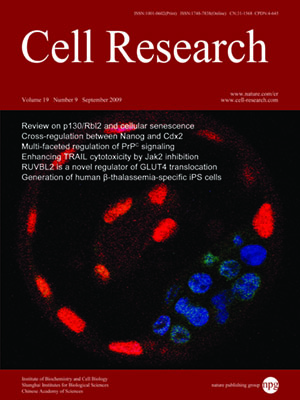Volume 19 Issue 9, September 2009: 1062-1078
ORIGINAL ARTICLES
PrPC-related signal transduction is influenced by copper, membrane integrity and the alpha cleavage site
Cathryn L Haigh1,2, Victoria A Lewis1,2, Laura J Vella1,2,4, Colin L Masters2,5, Andrew F Hill2,3,4, Victoria A Lawson1,2 and Steven J Collins1,2
1Department of Pathology, The University of Melbourne, Parkville, Melbourne, 3010, Australia
2Mental Health Research Institute, The University of Melbourne, Parkville, Melbourne, 3010, Australia
3The Department of Biochemistry and Molecular Biology, The University of Melbourne, Parkville, Melbourne, 3010, Australia
4Bio21 Molecular Science and Biotechnology Institute, 30 Flemington Road, The University of Melbourne, Parkville, Melbourne, 3010, Australia
5Centre for Neuroscience, The University of Melbourne, Parkville, Melbourne, 3010, Australia
Correspondence: Steven J Collins,(stevenjc@unimelb.edu.au)
The copper-binding, membrane-anchored, cellular prion protein (PrP
C) has two constitutive cleavage sites producing distinct N- and C-terminal fragments (N1/C1 and N2/C2). Using RK13 cells expressing either human PrP
C, mouse PrP
C or mouse PrP
C carrying the 3F4 epitope, this study explored the influence of the PrP
C primary sequence on endoproteolytic cleavage and one putative PrP
C function, MAP kinase signal transduction, in response to exogenous copper with or without a perturbed membrane environment. PrP
C primary sequence, especially that around the N1/C1 cleavage site, appeared to influence basal levels of proteolysis at this location and extracellular signal-regulated kinase 1/2 (ERK1/2) phosphorylation, with increased processing demonstrating an inverse relationship with basal ERK1/2 activation. Human PrP
C showed increased N1/C1 cleavage in response to copper alone, accompanied by specific p38 and JNK/SAPK phosphorylation. Combined exposure to copper plus the cholesterol-sequestering antibiotic filipin resulted in a mouse PrP
C-specific substantial increase in signal protein phosphorylation, accompanied by an increase in N1/C1 cleavage. Mouse PrP
C harboring the human N1/C1 cleavage site assumed more human-like profiles basally and in response to copper and altered membrane environments. Our results demonstrate that the PrP
C primary sequence around the N1/C1 cleavage site influences endoproteolytic processing at this location, which appears linked to MAP kinase signal transduction both basally and in response to copper. Further, the primary sequence appears to confer a mutual dependence of N1/C1 cleavage and membrane integrity on the fidelity of PrP
C-related signal transduction in response to exogenous stimuli.
Cell Research (2009) 19:1062-1078. doi: 10.1038/cr.2009.86 published online 14 July 2009
FULL TEXT | PDF
Browse 1922


